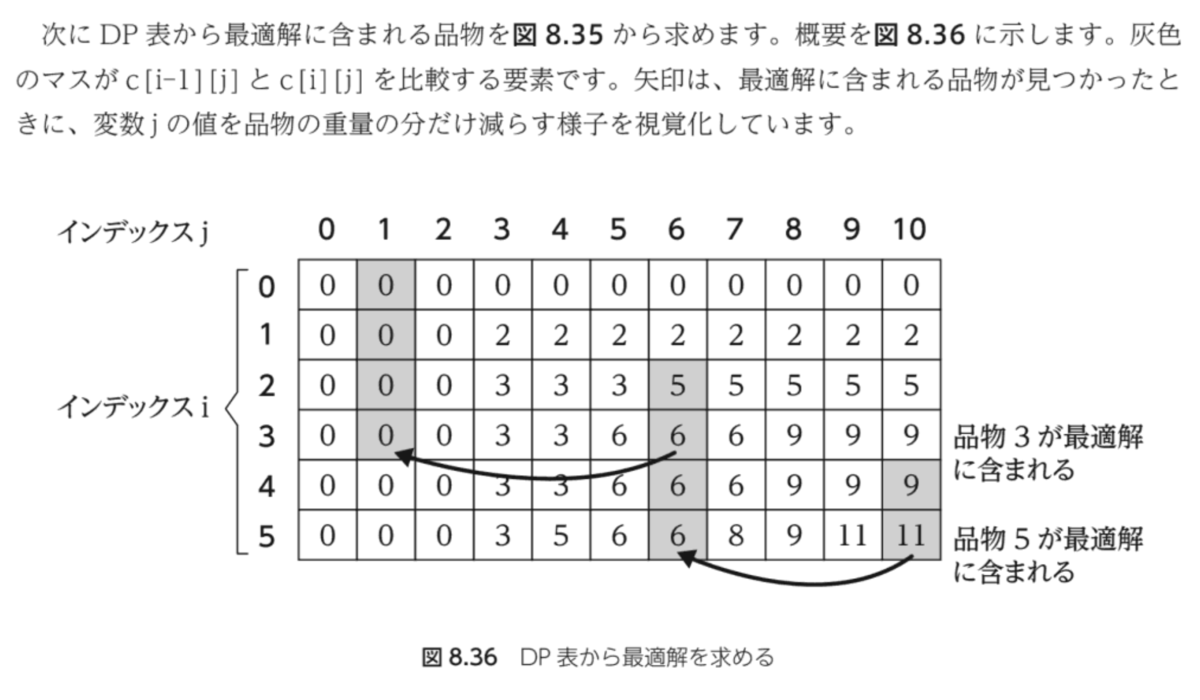items = ((2,3),(1,2),(3,6),(2,1),(1,3),(5,85)) MAX_WEIGHT=4
1. 動的計画法
DPテーブルからアイテムの組み合わせを求める方法はこの本の記述を参考にした。
books.google.co.ke


#!/usr/bin/env python import numpy as np np.set_printoptions(linewidth=100) wvs = [(2,3),(1,2),(3,6),(2,1),(1,3),(5,85)] n = len(wvs) W = sum([wv[0] for wv in wvs]) dp = np.zeros((n+1,W+1)) for i in range(1,n+1): for w in range(W+1): if(w-wvs[i-1][0]>=0): dp[i][w] = max(dp[i][w],dp[i-1][w-wvs[i-1][0]]+wvs[i-1][1]) dp[i][w] = max(dp[i][w],dp[i-1][w]) print(dp) # calculation of the combination of items MAX_WEIGHT=4 ans = max([d[MAX_WEIGHT] for d in dp]) dp2 = dp[:,:MAX_WEIGHT+1] m, n = np.shape(dp2) last = dp2[m-1,n-1] taken = [0]*(m-1) j = n-1 i = m-1 #print(dp2) while j > 0 and i > 0: i -= 1 cur = dp2[i,j] if last-cur > 0: taken[i] = 1 j = j - wvs[i][0] last = dp2[i][j] continue print("given weight:",MAX_WEIGHT) print("combination:",taken) print("maximum value:",ans)
2. 遺伝的アルゴリズム(DEAP)
この本を参考にした。
https://www.amazon.co.jp/dp/B094993THZ/ref=dp-kindle-redirect?_encoding=UTF8&btkr=1
from deap import base, creator, tools, algorithms import random import numpy as np #items = ((8,10),(7,13),(6,7),(5,4),(4,9),(3,3,),(2,3),(1,2)) items = ((2,3),(1,2),(3,6),(2,1),(1,3),(5,85)) creator.create("Fitness", base.Fitness, weights=(1.0,)) creator.create("Individual",list,fitness=creator.Fitness) toolbox = base.Toolbox() toolbox.register("attribute",random.randint, 0, 1) toolbox.register("individual",tools.initRepeat,creator.Individual,toolbox.attribute, len(items)) toolbox.register("population",tools.initRepeat,list,toolbox.individual) #MAX_WEIGHT=10 MAX_WEIGHT=4 def evalKnapsack(individual): weight = 0.0 value = 0.0 for i in range(len(items)): s = individual[i] if s==1: weight += items[i][0] value += items[i][1] if weight > MAX_WEIGHT: return 0, return value, toolbox.register("evaluate",evalKnapsack) toolbox.register("select",tools.selTournament,tournsize=3) toolbox.register("mate", tools.cxTwoPoint) toolbox.register("mutate",tools.mutFlipBit, indpb=0.05) hof = tools.ParetoFront() stats = tools.Statistics(lambda ind: ind.fitness.values) stats.register("avg",np.mean, axis=0) stats.register("std",np.std, axis=0) stats.register("min",np.min, axis=0) stats.register("max",np.max, axis=0) pop = toolbox.population(n=50) algorithms.eaSimple(pop, toolbox, cxpb=0.8,mutpb=0.5,ngen=100,stats=stats,halloffame=hof, verbose=True) best_ind = tools.selBest(pop,1)[0] print(best_ind) print(evalKnapsack(best_ind))
3. 線形計画問題(PuLP)
ここを参考に。
dev2prod.site
from pulp import * #w = [4,2,2,1,10] #v = [12,2,1,1,4] #W = 15 w = [4,2,2,1,10] v = [12,2,1,1,4] W = 15 r = range(len(w)) m = LpProblem(sense=LpMaximize) x = [LpVariable('x%d'%i, cat=LpBinary) for i in r] m += lpDot(v,x) m += lpDot(w,x) <= W m.solve() print('max value: {} / combination:{}'.format( value(m.objective), [i for i in r if value(x[i])>0.5]))